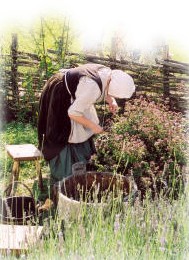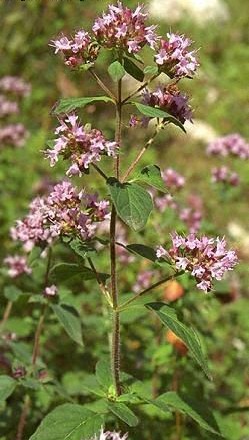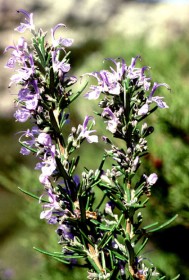|
Mediterranean herbs
(By Michael Politis)

|
|
Collecting
herbs
|
The very first ancient documents about plants (Babylonian souces, the Old
Testament, Homers's works) that came down on us regarded plants mainly
under the aspects of utility and medicinal use.
No one knows when herbs were first collected in the wild or planted in
gardens, but Egyptian records dating back to 2800 BC show herbs were being
prescribed as medicine, and being used for food, cosmetics, perfumes, and
dyes.
The interest of the old Greek philosophers focused more on the comparison of animal and man on one hand and plants on the
other. Empedocles from Agrient, for example, dwelt on the question whether plants have a soul while
Aristotle ranks them in the middle between the inanimate and the animate.
Theophrastus wrote two works of a general nature on plants: The Natural History of Plants and About the Reasons of Vegetable
Growth. Both had a formative influence on the botanical research of following
scientists.
An estimated 1300-1400 different plant species were known under Roman reign. The interest of the Romans concentrated more on practical
problems: Pliny the Older reviewed plants mainly under aspects of utility while the work of
Dioscoride on pharmacology gained him the reputation as the superior authority on this subject for more than sixteen centuries to
come. He describes more than 500 different plant species.
It's obvious that Ěediteranean
region is the place in which the sience of botany was born. For that reason
mediterranean herbs takes an extremely important part in the history of botany.
The area around the Mediterranean Sea, belonging in part to Europe, Asia and
Africa, has always been a cultural unity. Herbs were brought from the
Mediterranean to the Orient and then to Europe.Early spice trading routes lead from China and India via the Arab peninsular to the Mediterranean
Sea, which made the region an important place of cultural and culinary
exchange. In the warm Mediterranea climate, many fragrant plants grew
abundantly; and in the course of millennia, even more have been introduced by
traders, refugees or immigrants from further East. For the purposes of this article we will consider herbs and spices to be the
same.
Asian spices became popular in Europe first in the Age of Hellenism. Later, spice trade blossomed in the late days of the
Romans, about two thousand years ago; from the beginning, spice trade was dominated by the
Arabs. Apicius' De re coquinaria is one of the oldest European cookbooks; it lists some tropical
spices, of which long pepper was most valued. Black pepper, cloves and chinese cinnamon
(cassia) also figure prominently. The enigmatic spice silphion (probably of Northern African
origin) became extinct around 100 AD and was substituted by asafetida (from Central
Asia). The usage of olive oil is a cultural constant in the Mediterranean since five
millennia.
Today, Mediterranean Europe mostly relies on its native or imported herbs. Basil
(stemming originally from South or even South East Asia) today grows wild all over South Europe and is used
extensively, especially in Italian cuisine; the same holds for the indigenous
oregano. Garlic figures more prominently than in Northern European countries.
Regionally, saffron is used for fish or sea food specialities, but the high price of this spice limits its
usage. Throughout the region, some dishes require small amounts of chiles; fiery
food, however, is not typical.
Typical spice mixtures from Southern Europe are bouquet garni and Herbes de Provençe.

|
|
Oregano (Origanum
vulgare)
|
In Asia Minor and West Asia, herbs cease to be dominant. Coriander and cumin
(from Persia, but grown locally) are popular, and the use of pungent spices
(mainly black pepper and chiles) becomes more common. The berries of the sumac tree are essential to reproduce the tart and sour taste found in many dishes from Turkey to
Israel.
In Northern Africa, chiles take an important part in fiery stews and sauces. Coriander and cumin both
are used extensively, but also African spices (grains of paradise) are
common. Of the spices from tropical Asia, cinnamon and cloves find most use. All
these, and more, may appear in Moroccan spice mixtures (ras el hanout).
Although a large number of Mediterranean herbs is discussed
here, the treatment is not exhaustive: There are many more that find their way in the kitchen on
occasion. Sometimes, these are wild relatives of herbs treated here which are collected by knowledgeable family
members, because their flavour is regarded superior to that of commercially grown
ones. This usage is often very local and is hardly mentioned in cookbooks. This applies particularily to herbs of the mint
family, e.g., thyme, marjoram and especially oregano.
The mint family (Lamiaceae or Labiatae) is especially common in this part of the
world and also as a source of herbs
from there.
Among these are rosemary (Rosmarinus officinalis,) thyme (Thymus
vulgaris and other species), oregano (Origanum vulgare) marjoram ( O. majorana) and dittany of
Crete (Origanum dictamnus).
Basil (Ocimum basilicum) is also widely used. Sage (Salvia officinalis)
has been used since Greek times. Most sage, today, comes from Yugoslavia. It was
often used medicinally.
"Mint", usually spearmint (Mentha spicata) or peppermint (M. piperita) are widely
used. The essential oils from these plants are
extremely important for flavoring hundreds of products, e.g., toothpaste,
mouthwash and chewing gum.
The other major family of
Mediterranean herbs is the Apiaceae
or Umbelliferae. In this group are parsley (Petroselinum crispum) and
chervil (Anthriscus cerefolium). Dill (Anethum graveolens) and
coriander or cilantro (Coriandrum sativum) are widely used as a fruit and
as the leaf material.
Fennel (Foeniculum vulgare),cumin (Cuminum cyminum),anise (Pimpinella anisum), celery seed
(Apium graveolens), and caraway (Carum carvi)
are all used as the fruit. The essential oils in the fruits are borne in special
oil glands.
The Brassicaceae or Cruciferae are also very important as herbs.
The seeds of Brassica nigra and B. alba have long been used.
Other herbs
from the Mediterranean include: tarragon (Artemisia dracunculus, Asteraceae or
Compositae),
laurel ( Laurus nobilis, Lauraceae), saffron (Crocus sativus, Iridaceae).
Saffron is the dried stigma of the flower. It is extremely expensive.
These herbs were pretty
much available in Europe before trade with Asia became important. The exotic
spices that fostered European exploration came mostly from India and southeast
Asia.
The following are generally
considered as native Mediterranean plants; however, some are open to dispute,
e.g., cumin or even the appearently “typical Mediterranean” olive.

|
|
Rosemary (Rosmarinus
officinalis)
|
Ajwain (Trachyspermum ammi)
Anise (Pimpinella anisum)
Coriander (Coriandrum sativum)
Cumin (Cuminum cyminum)
Fennel (Foeniculum vulgare)
Hyssop (Hyssopus officinalis)
Garden cress (Lipidium sativum)
Lavender (Lavandula angustifolia)
Mahaleb cherry (Prunus mahaleb)
Myrtle (Myrtus communis)
Nigella (Nigella sativa)
Oregano (Origanum vulgare)
Olive (Olea europea)
Rocket (Eruca sativa)
Rosemary (Rosmarinus officinalis)
Rue (Ruta graveolens)
Sage (Salvia officinalis)
Saffron (Crocus sativus)
Savory (Satureja hortensis)
Sumac (Rhus coriaria)
Thyme (Thymus vulgaris)
Further interesting plants from the Mediterranean
are:
Black lovage (alexanders, Smyrnium
olusatrum, Apiaceae) is similar to lovage and celery, having aromatic roots, leaves and
fruits. Today, the culinary importance of that herb is low.
Mastic is a resin obtained from Pistacia lentiscus var. chia (Anacardiaceae), a tree growing only on the island of Chios in Eastern
Greece, though lesser qualities are harvested from related species. It was an important commodity in the Middle
Ages, but is now only used in Greek cooking.
Pennyroyal, Mentha pulegium (Lamiaceae), differs markedly from culinary mints. It is used since antiquity in Roman
cooking. Despite its mild toxicity, it is a traditional herb in Britain.
Calamint, Calamintha nepeta, is an aromatic herb used in regional Italian cooking
(nepitella). Its flavour reminds to related Lamiaceae herbs, e.g., thyme, mint savory or
oregano.
Pine nuts (pignoli) are the seeds collected from the Mediterranean stone pine (Pinus
pinea, Pinaceae/Pinales); in temperate Asia, related pine species are also used. They have a wonderful
etheral-aromatic flavour and are particularily important in Spanish and Italian
cooking, e.g., for pesto.
Purslane (Portulaca oleracea, Portulacaceae/Caryophyllales) is an annual herb probably native to the
Himalayas, but today naturalized in Westarn Asia and Southern Europe. Although often eaten cooked as a
vegetable, the raw leaves and stems have a crispy texture and a salty, fresh taste that makes them a good garnish for Mediterranean cold
foods, e.g., West Asian appetizers. The flower buds have a more pronounced flavour and have been tried as a caper
substitute.
Samphire (Crithmum maritimum, Apiaceae) grows along all coasts of Europe, from the Atlantic Ocean to the Black
Sea. The leaves are succulent with a salty-aromatic flavour and have been a popular flavouring for salads in the
past; samphire pickle, formerly much eaten in Britain, is now still popular in the
Mediterranean.
Michael
Politis
|
